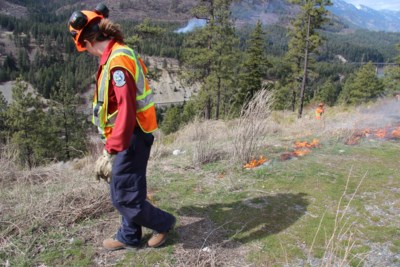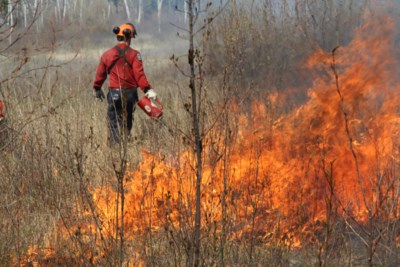
Throughout September, KamloopsMatters will be profiling a BC Wildfire Service employee at the Kamloops Fire Centre. KFC coordinates the wildfire response across south-central B.C., from Blue River in the north to the U.S. border in the south, and from Bridge River in the west to Monashee Mountains in the east. The fire centre employs around 50 permanent staff and a large number of seasonal support staff.
The goal of this 10-part feature is to give our readers a better understanding and a bird's-eye view of what happens at the centre, and to put a face to the people who are behind the scenes and on the frontlines.
Nicole Bonnett wears many hats at the Kamloops Fire Centre.
She's one of two prevention specialists, who help coordinate prescribed burns and educate the public about the province's FireSmart program. The latter is ensuring members of the community are aware of what steps to take to protect themselves (and property) from wildfire.
"FireSmart is something that can be done year-round. Prescribed burning is something we do in what we call the shoulder season, in the spring and fall," Bonnett tells KamloopsMatters.
Prescribed burns (fires purposely set) can be arranged for a variety of reasons.
 Nicole Bonnett at a prescribed burn. (via BC Wildfire Service)
Nicole Bonnett at a prescribed burn. (via BC Wildfire Service)That can include habitat improvement, community protection (burning combustible materials that have built up on the forest floor), and ecosystem restoration. And it's not just the BC Wildfire Service initiating the burns. It's not unusual for the organization to be approached by biologists, a municipality or a First Nations group looking to burn.
"When somebody identifies a project area, sometimes they want our guidance," says Bonnett. "Sometimes they want us to help throughout the whole project, but we may not be involved in all the steps."
Bonnett, who started with the BC Wildfire Service in 2017 as a dispatcher, points to a prescribed burn carried out in the Keremeos area earlier this spring. The burn was done in partnership with the Lower Similkameen Indian Band and the Okanagan Nation Alliance.
"They wanted to burn for community protection, but as well for big horned sheep habitat," she says.
A prescribed burn can take months to plan.
"You need to get the ball rolling the previous fall because you'll have to come up with a prescription for the land, and that might include prescribed fire and the treatment for the land, and sometimes there's prework to be done," she says.
Bonnett's job is to make sure all the moving parts align. From liaising with all the parties involved to doing site visits, if required.
"It’s not just something that we are like, 'It would be a good idea tomorrow to go burn a couple of hectares.'"
"There’s a lot that goes into it from the fire behaviour side. You have to look at what the weather typically or historically does in that area for the time period you’re hoping to do the burn. You have to decide what kind of intensity you want the fire to burn at. Do you want a low-intensity burn? Are you just looking to remove the ground fuels, or do you want to do a stand-replacing burn?"
There's also determining what kind of ignition will be required: hand or aerial.
 A prescribed burn. (via BC Wildfire Service)
A prescribed burn. (via BC Wildfire Service)"We have people who are well-trained, very experienced in that," says Bonnett. "(My job) is coordinating those pieces to make sure they're done in a timely manner, and that everyone needed to be kept in the loop is kept in the loop."
The FireSmart aspect of Bonnett's job is all about teaching the public and local governments about the program and how it works. Last year, the province rolled out the Community Resiliency Investment Program. The program aims to reduce wildfire risks by providing funding and FireSmart initiatives to B.C.'s communities
"It's a lot of engagement and education," Bonnett says of that aspect of her role.
When fire season hits, being a prevention specialist could also mean filling in as a fire information officer or helping the fire origin and cause crews.
At the end of the day, the thing Bonnett loves about her job is being able to create all those relationships. Both inside the office and outside.
"I grew up in our fire centre, so it’s kind of nice to be able to support the areas that I called home for the majority of my life."
Editor's note: This is the fourth article in the 10-part feature. Read part one here, part two here, and part three here.

 Parties cooperate in court
Parties cooperate in court Midway transformer fire
Midway transformer fire Woman not guilty after rant
Woman not guilty after rant Premier stands by pick
Premier stands by pick Canada's most-wanted list
Canada's most-wanted list Sask. will still get rebates
Sask. will still get rebates Santos ends comeback bid
Santos ends comeback bid Douglas C-54 plane crashes
Douglas C-54 plane crashes Trump's 'eyes and ears'
Trump's 'eyes and ears' Phish fans enter the Sphere
Phish fans enter the Sphere CN Rail profits fall
CN Rail profits fall  Tesla's Q1 income tumbles
Tesla's Q1 income tumbles Iginla off to Europe
Iginla off to Europe Rockets ink prospect
Rockets ink prospect Leafs even series
Leafs even series Alleged Tupac killer in court
Alleged Tupac killer in court Lawsuit accuses Megan
Lawsuit accuses Megan Bam Margera’s tour axed
Bam Margera’s tour axed
















